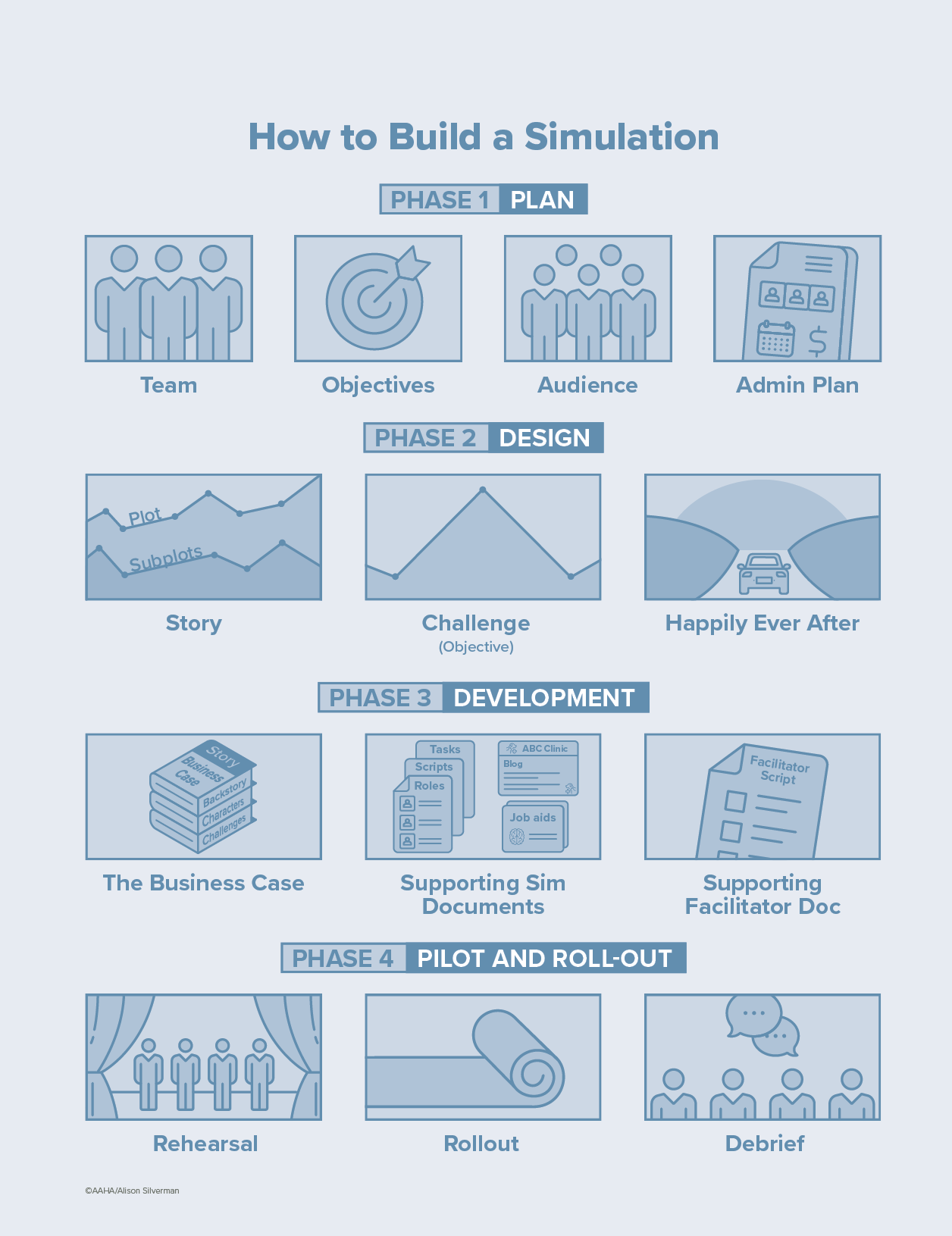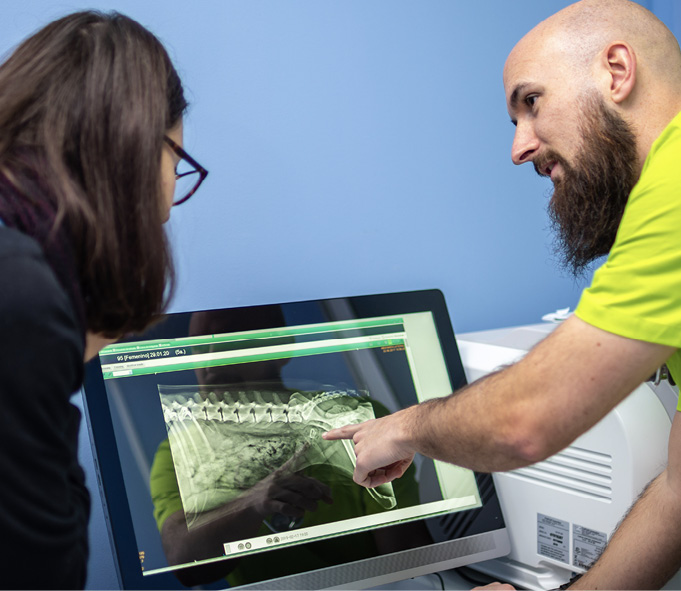Boost Your Training Game with Simulations
Simulations Engage Employees and Teach Valuable Soft Skills
by M. Carolyn Miller, MA

“A simulation (sim) is a story, rolled out across time. It mimics a “day in the life” of the employee audience.”
Training your staff is not just about teaching new skills or behaviors. It is also an employee engagement and onboarding tool. In fact, 48% of employees say training opportunities are one of the reasons they are attracted to an employer, according to the Society for Human Resource Management (SHRM). And when it comes to how they like to learn, nearly two in three employees, or 64%, prefer simulation learning today, according to SHRM.
While simulations are often used to teach technical skills in veterinary medicine, they are also valuable with soft skills such as customer service, leadership, and conflict resolution.
What Exactly Is a Simulation?
Despite the buzz around simulations (sims) today, there is often confusion about what is and isn’t a sim. A role play is not a sim, nor is putting the training experience online and adding some digital bells and whistles. A sim is larger and more inclusive than that.
A sim is a story, rolled out across time. That story mimics a “day in the life” of the employee audience, complete with plots, subplots, characters, and challenges. There is also a protagonist, the sim participant, who faces challenges he/she/they must overcome.
A simple example of a sim is a fire drill. There is a lead character (the person who knows the process), a process, and “characters” in the story who follow the leader’s direction. A training sim operates much the same way, albeit more complex. It is also strategically designed and multilayered.
One of the values of the sim experience is its real-life feel. Unlike traditional training, employees get to step into the story and don roles. They face challenges and can impact the story’s outcome, be it saving a client or saving the clinic from financial disaster. How heroic is that?
The Heart of the Sim: Strategic Storytelling
The story the sim tells is not merely for entertainment. It has been strategically designed to achieve very specific learning outcomes. And all the parts of the story, from the plots and subplots to the characters and their quirks, are in service to the sim’s objectives.

“The story the sim tells has been strategically designed to achieve very specific learning outcomes.”
For instance, if you want your sim to teach a specific customer service process, the storyline might be about a new customer coming into the clinic (the plot), complicated by a coworker’s absence (a subplot). The sim participant must not only use a customer service process to satisfy the new customer (a challenge). He/she/they must also manage the stress of extra work due to a coworker’s absence (another challenge).
Assessments of how well the sim participant is doing are also built into the sim. These are disguised as rewards and penalties within the context of the sim story. Most sims have three rounds so that the sim participant can practice and improve as he/she/they moves through the sim.
In the old days of training, sims were rolled out in big conference rooms with lots of paper and activity. Increasingly, sims are moving online. They are also, often, a mix of online and in-person, or hybrid, rollouts. Regardless, the process used to build a sim is the same.
How to Design a Sim

Printable Handout for
|
Creating an effective sim involves four phases. Those phases include planning, such as identifying the sim team and the sim’s objectives. The second phase is the actual design of the story that will play out in the sim.
The third phase involves developing the supporting materials that will bring the story to life, such as a business case that sets up the premise of the story and provides background information.
The last phase involves conducting a pilot to tighten up the story and identify additional needs. This phase also includes rolling out the sim and then debriefing it with the sim participants.
Phase 1: Sim Planning
Sim planning has four components. The first component is identifying the sim’s objective. This includes identifying the behaviors to teach that will accomplish the sim’s objectives.
For instance, with a customer service process, the objective may be to bring more clients into the practice. A behavior that would support that might be active listening. This behavior would be disguised in the sim via a customer interaction where the sim participant can practice doing just that.
The next planning component is to identify the team members who will be involved in creating the sim. Ideally, you want staff that have expertise in the area you’re teaching. You also want a creative team member who can take the lead on the story’s development and writing materials.
Because the sim will mimic a “day in the life” of the sim participant, it is critical to know what kind of day your employee audience experiences that is mimicked in the sim. This can include frustrations and challenges. It’s also helpful to have a sense of what excites sim participants about their jobs so you can weave those internal rewards into the sim.
Finally, administrative issues must be outlined. These include identifying the resources, in time, people, and budget. It also includes identifying how to overcome any system constraints such as sim participants who work different schedules. The sim’s timeline and the larger practice timeline must also be factored in.
Phase 2: Sim Design
This phase of sim design involves concepting out the story, including the major plot and subplots. This is similar to how a writer outlines a novel. The difference is that the sim story uses a fictitious version of a workday, including its characters and challenges.
Every story has a moral, and a sim story is no different. Here, those “morals” are the designer’s learning objectives, embedded in every part and person in the story. This includes characters and challenges the sim participant must navigate successfully to reach “happily ever after,” that is, meet the sim’s learning objective. (This often takes the form of a presentation or celebration.)
A sim story is usually drafted on a storyboard, that is, a spreadsheet that maps the story across time. Character and plot development move through the storyboard, with multiple “scenes” or rounds that progress the storyline.
That story also brings to life the behaviors being learned and the end goal of behavior change. Distractions and interruptions are also often introduced into the sim at critical times to emotionally charge the sim story, not unlike a typical workday.

Phase 3: Sim Development
This phase of sim development is the most detailed. It involves creating and formalizing all the parts and pieces outlined in the storyboard, but at a micro level. Together, these documents bring the story to life.
The Business Case
Prior to the sim, the sim story, in the form of a business case, is distributed to sim participants. Its purpose is to define what a sim is and how it works. It also communicates logistical information and sets the stage for the sim story. It introduces characters. It describes the larger context of the story such as the market climate triggering the sim challenges. It also outlines the sim participant’s role and challenges to overcome in the upcoming sim.
Supporting Sim Documents
Supporting documents bring the story to life. They also embed information the sim participant needs to move through the sim. These can include paper and digital materials such as emails and texts. They can also include sim distractions and interruptions. Job aids may be created to outline the new behaviors you’re teaching. Drafting scripts and enrolling talent to record those scripts may also be part of this phase.
Hybrid and online sims may also have a website and blog to further bring the fictious clinic to life, and communicate information. Examples include market information or the buzz on the street via comments on a blog post.
Finally, to assess whether the sim participant is learning what the sim is teaching, sim designers mask “tests” using story elements. For instance, if the goal is to save a client from leaving the practice and the participant omits critical steps, the actor playing the client can choose to walk out the clinic door. The participant “fails” the test. In the next round, he/she/they have a chance to try again with another client. This is why a sim occurs over time.
Because you are creating a believable “alternate reality” via the sim story, it’s critical to brand all materials, digital and paper, with the fictitious clinic’s look and feel, in graphic elements, the name of the clinic, and more.

And all the parts of the story, from the plots and subplots to the characters, are in service to the sim’s objectives.
Supporting Facilitator Documents
A sim facilitator is like a play’s director. He/she/they guides the characters and the action. That’s why a facilitator script or guide with talking points is critical.
Facilitator talking points outline where characters make their entrances and exits. It also enables the facilitator to guide the sim participants and inform them where they are in the story. Additionally, it identifies any materials or actions interjected in the sim.
The facilitator guide also includes debrief questions once the sim is done, to help sim participants review what they’ve learned. (The greatest learning is always in the debrief.)
Phase 4: Pilot and Roll-Out
Every theater production has a dress rehearsal, and so should every sim. A sim pilot shows you how to streamline the sim. It enables you to delete redundancies and surface any missing materials to create. It can also test any technology or timing glitches.
Once the pilot is done, you’re ready to roll out the sim. And once the sim has been conducted, the final step is to do a debrief so sim participants can assess and celebrate all they’ve learned.
 |
M. Carolyn Miller, MA, is a narrative instructional designer and award-winning writer who has been designing and developing sims for 30 years. www.cultureshape.com |
Photo credits: Prostock-Studio/iStock via Getty Images Plus, shironosov/iStock via Getty Images Plus, ©AAHA/Alison Silverman, DragonImages/iStock via Getty Images Plus, GaiBru_Photo/iStock via Getty Images Plus



